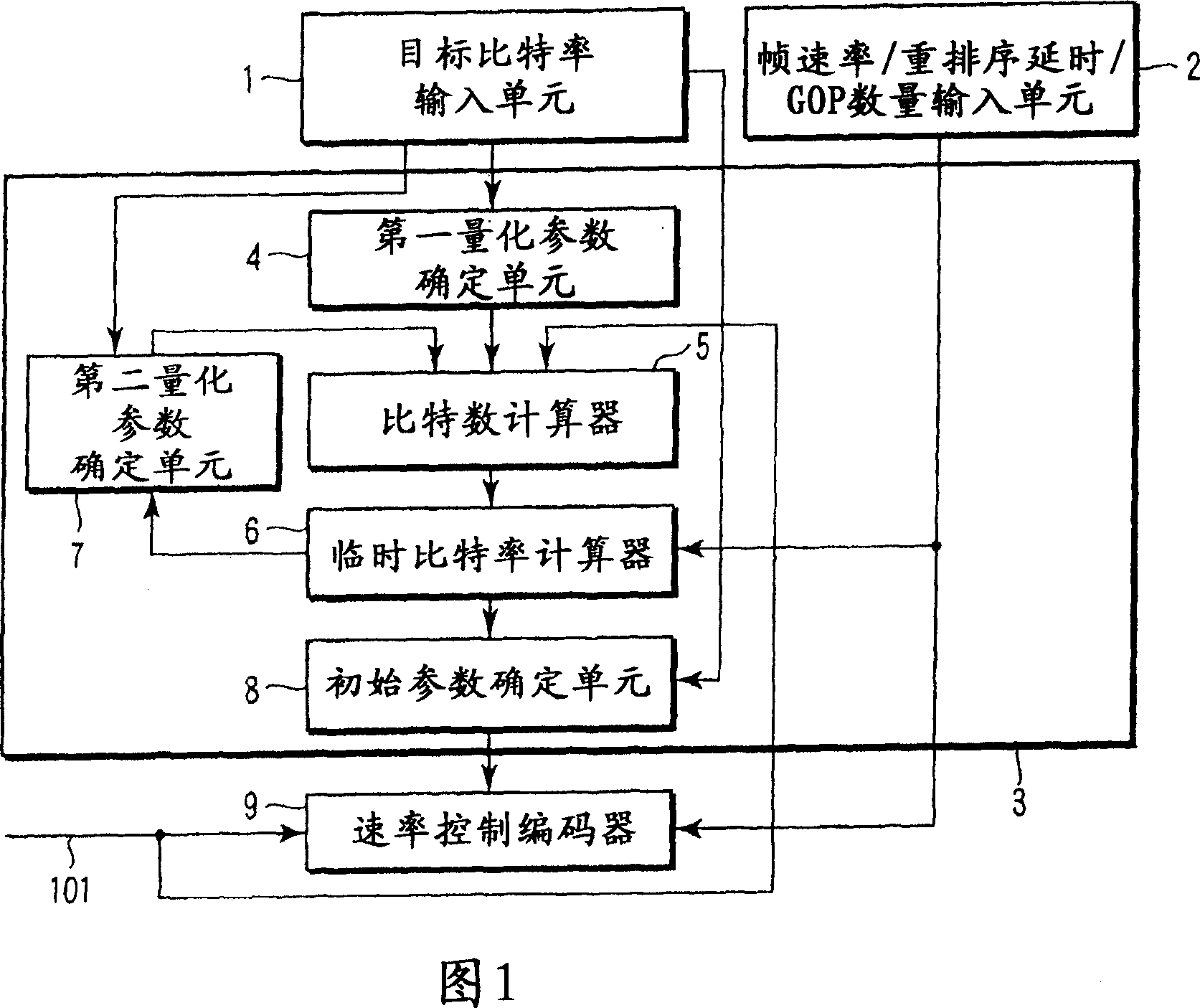Video encoding method and apparatus
A video coding and coding technology, which is applied in the field of rate control in video coding, can solve the problems of image quality degradation, large changes in image characteristics, and low accuracy of global complexity measurement
- Summary
- Abstract
- Description
- Claims
- Application Information
AI Technical Summary
Problems solved by technology
Method used
Image
Examples
no. 1 example
[0045]1 shows a video encoding apparatus according to a first embodiment of the present invention, said apparatus has a target bit rate (BR) input unit 1, a frame rate (FR) / reordering delay (M) / GOP number input unit 2, an automatic The initial parameter determination unit 3 and the rate control encoder 9 are adapted. The adaptive initial parameter determination unit 3 has a first quantization parameter (QP1) determination unit 4, a calculator 5 (referred to as a bit number calculator) for calculating the number of encoding bits for each image type, using the bit number of each image type Number of temporary bit rate calculator 6, second quantization parameter (QP2) determination unit 7 and initial parameter determination unit 8.
[0046] Figure 2 shows details of the rate control encoder 9 in Figure 1 . This example represents the main part of a video encoder implemented in relation to H.264. A video signal 101 is input to a subtractor 201 , which is the object to be coded, ...
no. 2 example
[0090] Next, a second embodiment of the present invention will be described. In the second embodiment, not only the initial value of the quantization parameter QP but also the initial value of the global complexity measure are determined in the initial parameter determination unit 7 of FIG. 1 .
[0091] Hereinafter, the global complexity measure will be explained. The global complexity measure is a parameter used in the system adopted in TM5 of MPEG-2. For TM5, a model is assumed where the product of the average quantization parameter and the number of coded bits is a constant value for each picture type unless the picture changes. In the formula below, X is the global complexity measure for each image type, S is the number of bits for each image type, and Q is the average quantization parameter for each image type.
[0092] X i = S ...
no. 3 example
[0102] Next, a third embodiment of the present invention will be described. In this embodiment, the adaptive initial parameter determination process S15 shown in FIG. 9 is executed in the video encoding device shown in FIG. 1 . In FIG. 9 , the process in step S12 is added to the adaptive initial parameter determination process S14 in the second embodiment shown in FIG. 7 .
[0103] Specifically, in the third embodiment, first in the same manner as in the second embodiment, the quantization parameter QP suitable for the target bit rate BR is calculated in the initial parameter determination unit 7 shown in FIG. 1 (step S9) . Next, the initial value of the global complexity measure is calculated using QP in the same manner as in the second embodiment (step S11). Thereafter, based on the quantization parameters QP1 and QP2, the number of bits of each image type I1, I2, P1, P2, B1, B2, the constant parameters in the update formula of the global complexity measure are determined ...
PUM
 Login to View More
Login to View More Abstract
Description
Claims
Application Information
 Login to View More
Login to View More - R&D
- Intellectual Property
- Life Sciences
- Materials
- Tech Scout
- Unparalleled Data Quality
- Higher Quality Content
- 60% Fewer Hallucinations
Browse by: Latest US Patents, China's latest patents, Technical Efficacy Thesaurus, Application Domain, Technology Topic, Popular Technical Reports.
© 2025 PatSnap. All rights reserved.Legal|Privacy policy|Modern Slavery Act Transparency Statement|Sitemap|About US| Contact US: help@patsnap.com



